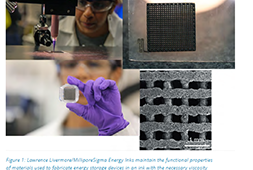
Last winter, MIT researchers discovered that a phenol-formaldehyde polymer transformed into a glassy carbon material in a process similar to baking reaches its best combination of high strength and low density at 1,000 degrees Celsius (1,832 degrees Fahrenheit). Now they have determined that, they can achieve a similar glassy transformation, but at a more industrially-accessible temperature of 800 C by adding a small fraction of carbon nanotubes to this material.
As the starting polymeric hydrocarbon, known as a phenol-formaldehyde polymeric resin, is heated from 600 C, the size of its crystallites grows until it reaches a plateau at 1,000 C. Postdoc Itai Y. Stein says scientific literature shows that this plateau holds until well above 2,000 C. The addition of 1 percent by volume of aligned carbon nanotubes to the starting material allows it to reach the plateau crystallite size at a termperature 200 C lower.
“What we’re showing is that by adding carbon nanotubes, we reach this plateau region earlier,” Stein says. The findings were reported Aug. 22 in the Journal of Materials Science online. The co-authors were Stein, former Materials Processing Center-Center for Materials Science and Engineering (MPC-CMSE) Summer Scholars Ashley L. Kaiser (2016) and Alexander J. Constable (2015), postdoc Luiz Acauan, and the senior author, professor of aeronautics and astronautics Brian L. Wardle. Kaiser is now a graduate student in Wardle’s lab.
Improving Manufacturability
“This work has the interesting finding that nanostructures assist in fabricating [and] manufacturing the glassy carbon composites,” Wardle says. “Early lessons with nano-materials broadly showed that nanostructures impede manufacturing, however, we are finding a theme across several research areas that when controlled, the nanostructures can be utilized to enhance manufacturing, sometime significantly. While the nanostructures — here, aligned carbon nanotubes — are valuable as reinforcement to the glassy carbon, they can also be utilized to improve the manufacturability. Ashley and Itai are taking this work even further to test the limits.”
Crystallite size is strongly tied to hardness, which is a measure of mechanical performance such as strength and toughness. It is one of the most important properties of the glassy carbon material.
“If you look at the hardness normalized by the density, we previously found that the first point in the plateau region is the best point, because there the glassy carbon material is the least dense and hardest,” Stein says.
The primary finding of the earlier paper was that more disorder in the arrangement of carbon crystallites led to greater hardness and lower density in the glassy carbon material, which was obtained by baking a phenol-formaldehyde polymer in the absence of oxygen. The transformed material is also called pyrolytic carbon or PyC.
Although the polymer transforms into a graphite-like material, it never reaches the more highly ordered structure of graphite. This difference is confirmed by X-ray diffraction (XRD) analysis of samples baked with, and without, carbon nanotubes and compared to a standard indicator for graphite known as the Bernal stacking order. The type of disorder among crystallites here is called turbostratic stacking, where the planes that comprise the crystallites are randomly rotated with respect to one another due to holes (or vacancies) and curvature. XRD studies carried out at the Center for Materials Science and Engineering’s shared experimental facilities also validated the crystallite size evolution in relation to baking temperature.
To imagine this disorder compared to the perfect hexagonal structure of graphene or repeating layered structure of graphite, Stein suggests thinking of a stack of flat square pieces of paper. The papers easily stack into a perfect square with minimal space between each sheet. But if each piece of paper is taken out, crumpled, and then lightly flattened out again, it would be frustrating trying to reorder the sheets into a neat stack.
Similar disorder occurs in the molecular structure of the glassy carbon, because the precursor phenol-formaldehyde polymer begins with a complicated mix of carbon-rich compounds and the baking temperature isn’t high enough to break down all of them into simpler carbon structures. Raman spectroscopy results confirmed the presence of these defects in the carbon structure. Another technique, Fourier Transform Infrared Spectroscopy, confirmed the presence of oxygen and hydrogen groups within the crystallites.
“It originates from the polymeric precursor that we use, the phenol-formaldehyde, and they’re just stuck; they can’t leave,” Stein explains.
The researchers’ earlier paper showed that the presence of these more complex carbon compounds in the material strengthens it by leading to three-dimensional connections that are hard to break. The new work shows that the carbon nanotubes have no effect on these oxygen or hydrogen substructures in the material.
Stein says that, for the current study, the goal was to explore what happens when carbon nanotubes are added and the baking temperature is increased; specifically, what effect, if any, the nanotubes have on crystallite growth. They found that the nanotubes influence the crystallite formation process on the meso-scale, which is measured in tens of nanometers, while everything else remains unchanged. Importantly, only the crystallite size is affected by the addition of the carbon nanotubes.
“We were surprised to see no change in the graphitic nature of our polymer as it is being baked in the presence of carbon nanotubes,” he says. “Nonetheless, that is a very interesting finding because we can reduce the processing temperature without affecting the structure of the resulting glassy carbon. Since the properties of the glassy carbon depend on its structure, this finding could allow an industrial process of this technology to realize significant energy savings.”
Faster Structural Evolution
“The carbon nanotubes allow the composite’s structure to evolve faster at the meso-scale, so it reaches its final state at a lower processing temperature,” Kaiser adds. “These nanotubes also decrease the overall weight of the material. This way, we are able to produce our composite at a lower temperature while decreasing its density and maintaining its excellent properties.”
Stein notes that in the earlier work the researchers also showed that increasing processing temperature above 1,000 C resulted in a weaker material.
“So we are essentially reducing the temperature you need to go to reach the best properties,” Stein says of the new report. “If you look at the hardness normalized by the density, this [800 degrees C] is the best point, because this is where the glassy carbon is expected to be the least dense and hardest.”
Stein says the lower processing temperature may also make these phenolic materials more compatible with metals whose melting points are below 1,000 C, which in turn may be useful for 3D printing.
“The application we specifically thought of using this in is meta-materials,” he says. “If you can use nanotubes to reduce the temperature you bake at, if you want to convert it to carbon, just pure carbon, then that could make it more accessible. That 200 degrees Celsius is a big difference for many processes.”
In the new findings, the researchers experimented on a material with just 1 percent carbon nanotubes by volume. They plan to follow up by studying the impact of increasing the proportion of carbon nanotubes to 20 percent by volume. “We just want to see if the nanotubes make it stronger, “ Stein says. They’ll also look at the effect on size and thickness of the crystallites from the added carbon nanotubes.
Next-Generation Nano-Structures
“A whole range of structural composites would benefit from this study, particularly next-generation ultra-lightweight nano-structures,” says Piran R. Kidambi, assistant professor of chemical and biomolecular engineering at Vanderbilt University, who was not involved in this research.
“The study found that aligned carbon nanotube-glassy carbon matrix nanocomposites at the meso-scale evolved much faster with a plateau in crystallite sizes (an important quality metric) at a temperature up to 200 degrees Celsius lower compared to having a pure glassy carbon matrix,” Kidambi says. “Lower temperatures are good news for manufacturing to minimize heating costs in processing, and recent models tell us that slender crystallites are desirable since they increase glassy carbon hardness. Hence a combination of a plateau in crystallite sizes and lower temperatures is very interesting from a manufacturing perspective. This is high-quality research that uses fundamental insights to inform and guide manufacturing/synthesis routes for superior composites.”
Summer Scholar Work
Kaiser’s work as a 2016 MPC-CMSE Summer Scholar makes up the bulk of the paper’s experimental results, except for the Raman spectroscopy results. “It is a very robust and focused contribution,” Stein says.
“I was thrilled to be involved in this research when I was a Summer Scholar,” Kaiser says. “Now, being able to come back to MIT as a graduate student, rejoin the Wardle group, and publish this work is very exciting. I’m eager to continue working on composites as I pursue my PhD here in materials science and engineering.”
This work received support from the Department of Defense, National Science Foundation MRSEC Program, and the MIT Materials Processing Center. Airbus, Embraer, Lockheed Martin, Saab AB, ANSYS, Hexcel, Saertex, and TohoTenax also provided partial support through MIT’s Nano-Engineered Composite Aerospace Structures Consortium. Stein was supported in part by a National Defense Science and Engineering Graduate Fellowship.
SOURCE: MIT




